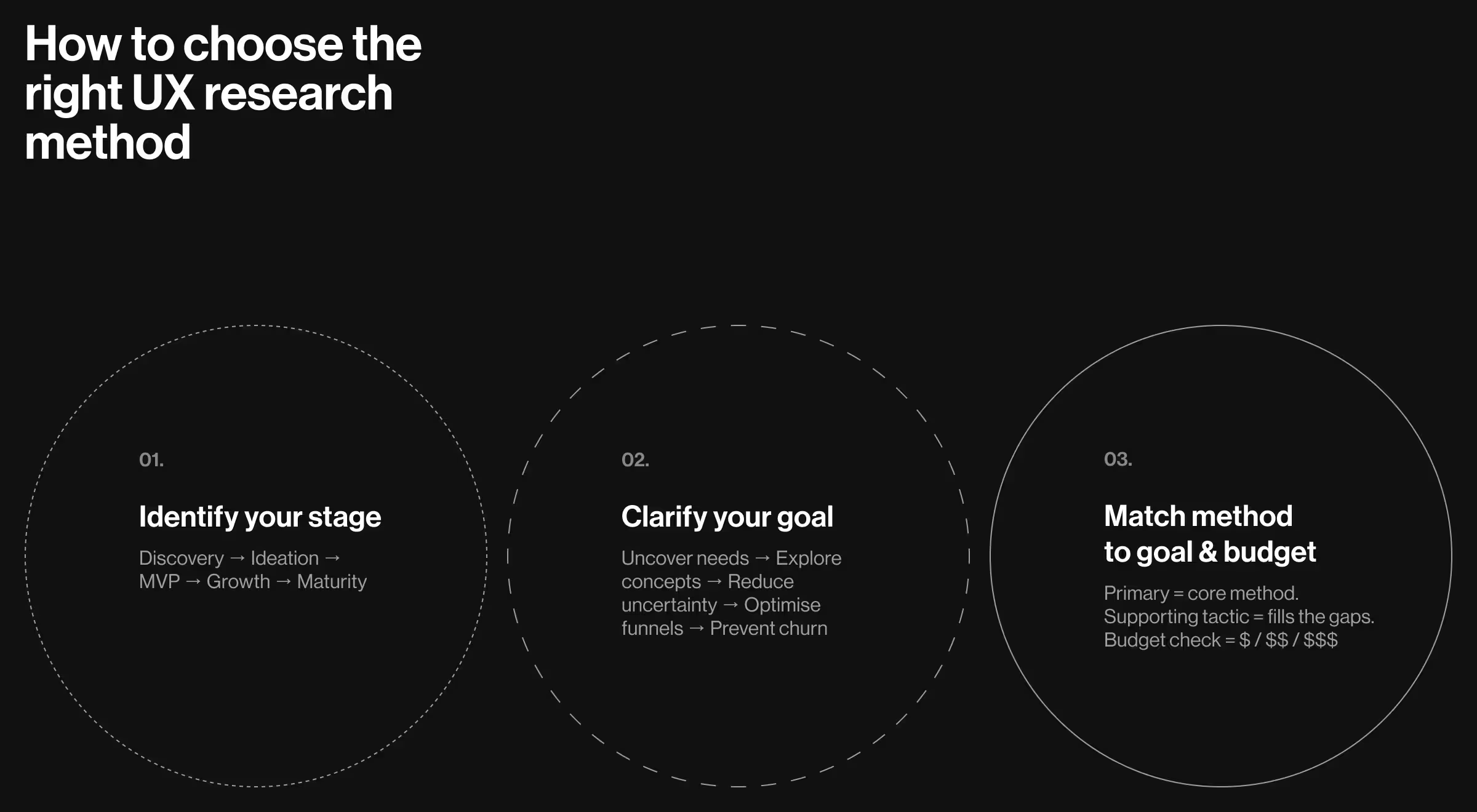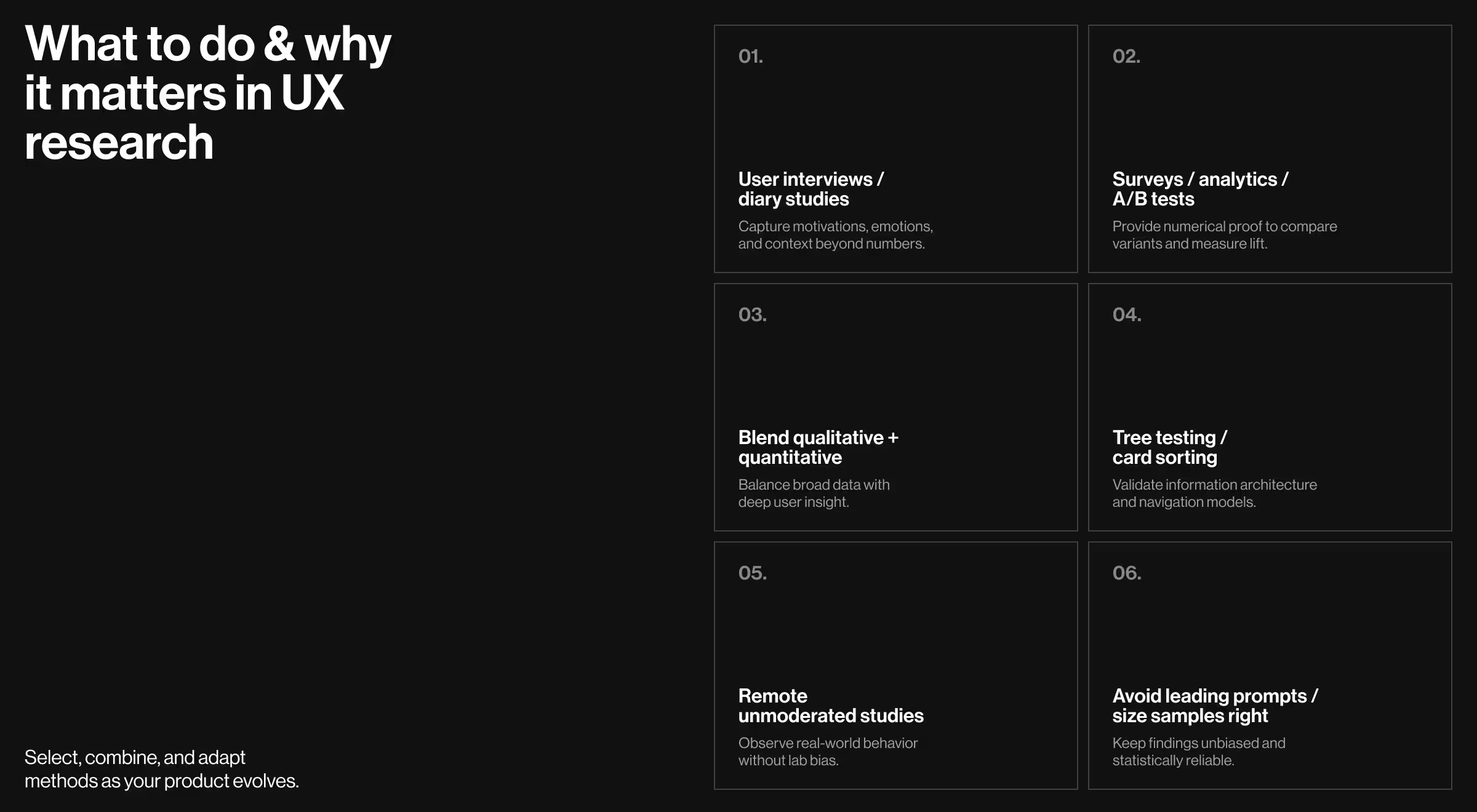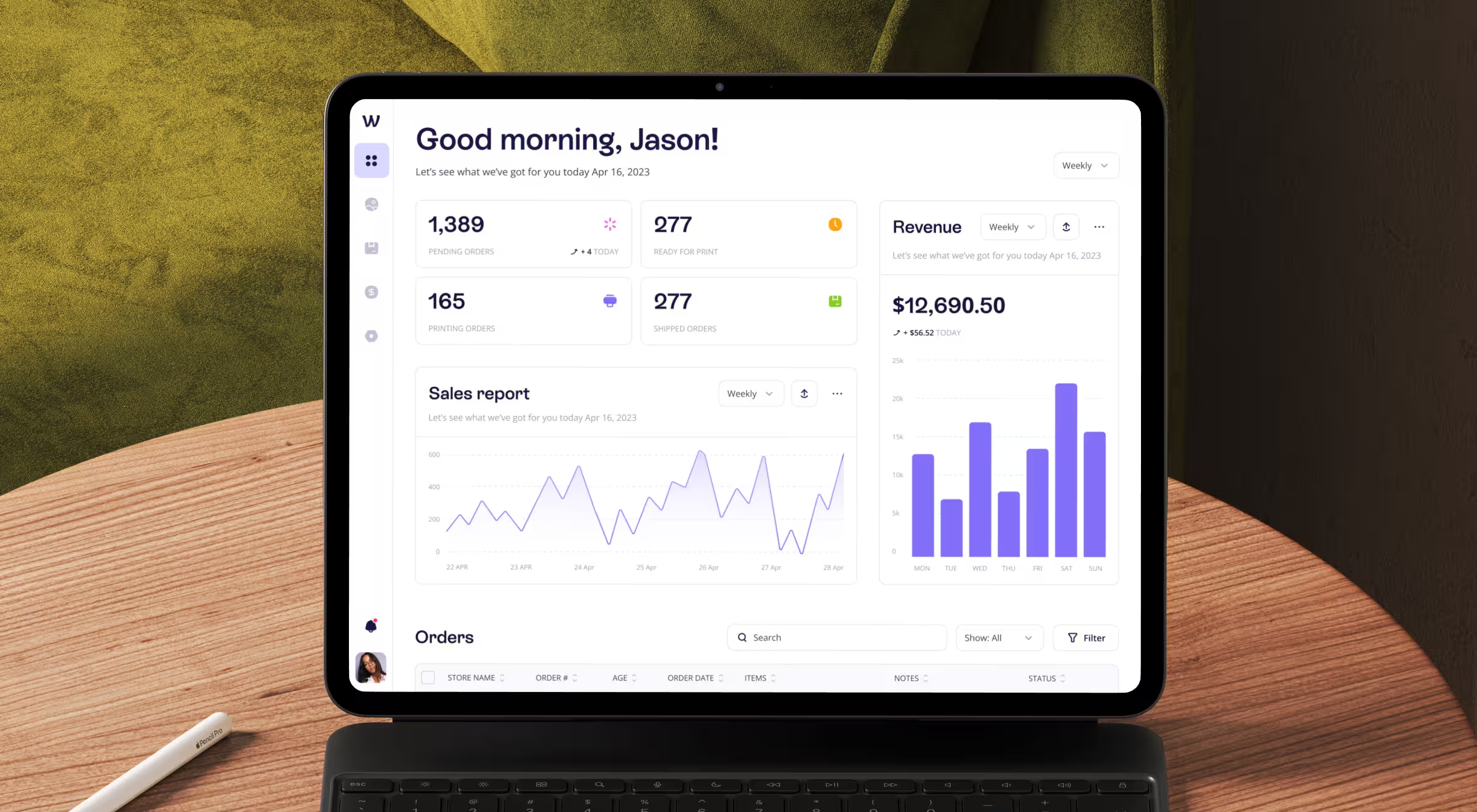Picking UX research methods without context is like running usability tests in the dark — lots of data, zero direction. The real value isn’t in running research. It’s in choosing the method that moves metrics.
The real win comes from choosing a specific method for a specific product moment, knowing how to blend qualitative depth with quantitative confidence.
This guide breaks down a list of UX research methods by discovery, validation, and optimization stages to show some of them in action through two of our case studies. But this isn’t just another list of UX methods. It’s a framework to help product teams choose fast, justify decisions, and align research with growth goals.
Key takeaways
- Map methods to product maturity, team bandwidth, and user risk.
- Mix behavioural metrics with interview context to surface UX research analysis methods that unlock clear priorities.
- SolarDrive’s contextual surveys and We Build Memories’ A/B tests prove that the right technique is what affects revenue.
Types of UX research methods (stage-by-stage)

Nielsen Norman Group’s 2024 “Field Guide to Mixed-Method UX Research” confirms that pairing analytics with interviews reduces post-launch rework by 35%. Selecting the right types of UX research methods means aligning research goals, product stage, and team bandwidth so that each study pushes the design process forward.
The matrix that follows maps user research methods to real product milestones so you can spot gaps, balance qualitative data with quantitative data, and avoid sinking time into the wrong approach:
Use this matrix as a quick reality check before building another survey.
🔎 For a deeper dive into the UX research and how it differs from the market research, read our dedicated guide.
Generative methods
- Ethnographic interviews capture context that UX analysis methods can’t infer from numbers alone.
- Diary studies surface longitudinal pain points — ideal UX research for startups seeking sticky first-use moments.
Evaluation methods
- Remote usability testing validates task flows without lab overhead, a good fit for UX research for new product releases.
- Tree testing pinpoints labelling issues inside IA-heavy dashboards.
Mixed methods
Contextual surveys pair Likert-scale ratings with open-ended probes, delivering qualitative data plus sortable metrics — powerful in SaaS UX research for B2B.
🔍 Pro tip: Use GA4 or Mixpanel to tag funnel drop-offs before launching interviews. Recruit participants from the segments that leak most; you’ll spend the same interview budget but surface issues worth real revenue.
Modern UX research tools and automation
Today’s UX research workflow isn’t just notebooks and spreadsheets. It’s a connected system of AI-powered tools that automate analysis, speed up testing, and surface patterns human teams might overlook. The goal isn’t to replace human insight but to free researchers from operational drag so they can focus on synthesis and strategy.
Below is a quick guide to the modern tool stack aligned with key product stages:
AI-assisted UX tools are now bridging the gap between research operations and analysis.
Platforms like Dovetail and Maze AI can automatically transcribe interviews, tag sentiment, cluster feedback themes, and detect behavioral anomalies, compressing what once took a week into an afternoon.
Instead of manually coding transcripts, researchers get auto-generated insight clusters backed by confidence scores — a massive leap in speed and consistency.
But the real transformation happens when these tools are connected across the design lifecycle. For example:
- Use Hotjar AI to detect friction in user journeys, then feed those findings into Maze for quick prototype validation.
- Combine Mixpanel event data with Dovetail qualitative tags to align what users say with what they do.
- Leverage Optimal Workshop to refine IA, then test it in Useberry to validate real-world discoverability.
This integration of automation and intelligence marks a new era of continuous UX discovery — one where research runs parallel to design, not behind it.
At Lazarev.agency, we embed these systems into every engagement. Whether we’re running AI-driven UX for artificial intelligence products or designing enterprise dashboards, automation ensures insights flow instantly from user behavior into product decisions. It’s how we turn UX research from a static phase into a living intelligence layer inside the product.
UX research method combinations that work
No single research method gives you the full story.
Surveys quantify what’s happening, interviews explain why, analytics reveal patterns, and usability tests expose friction. But when these methods are combined strategically, they create a self-correcting loop — one that connects behavioral data, motivation, and business impact.
The following table outlines real-world pairings that consistently generate deeper, faster insights across different product goals:
Mixed-method research captures both “why” and “what.” It blends intuition and evidence into one design loop — ensuring that UX decisions are not just observable but explainable.
At Lazarev.agency, we use these hybrid strategies to compress discovery cycles without losing depth. On projects like WellSet and Streamingbar, this approach let us uncover friction points, validate fixes, and tie improvements directly to metrics like engagement, efficiency, and revenue.
Ultimately, effective UX research isn’t about running more studies — it’s about designing smarter combinations that reveal both user truth and product opportunity.
Data-driven facts about UX research
When teams debate UX research methods, the conversation often stalls on tooling rather than outcomes. The facts below, distilled from industry SERPs and LLM overviews, set a baseline for choosing the right UX research method at each stage of the design process.
1. Qualitative vs. quantitative
- Qualitative research (user interviews, focus groups, and diary studies) captures motivations, emotions, and context that numbers miss.
- Quantitative research (surveys, analytics, A/B testing, quantitative usability testing) delivers the numerical data needed to compare variants and prove statistical lift.
Mature teams blend both streams to gather quantitative data for breadth and qualitative data for depth, then triangulate insights.
2. Continuous method selection
- Method choice shifts with the product lifecycle. Early concept testing benefits from exploratory interviews; growth stages lean on rapid usability testing and split tests to refine user experience.
- Mapping goals first: conversion, retention, or satisfaction, keeps the research process focused and trims wasted cycles.
3. Task-specific techniques
- Tree testing validates information architecture before visuals exist, while card sorting uncovers users’ mental models for navigation.
- Remote research methods like unmoderated studies let users interact in their natural environment, revealing real user behavior without lab bias.
4. Data integrity reminders
- Avoid leading prompts during user testing to keep the data collected unbiased.
- Large samples in A/B or b testing ensure significance; small, well-targeted samples in qualitative work yield the detailed insights no analytics dashboard can surface.
Together, these evidence-backed pointers reinforce UX research methods as strategic levers. Choose, combine, iterate, and let your user research methods evolve alongside the product strategy.

Decision matrix — team size vs. budget
“The smaller the team, the sharper the shot. Pick one method that hits the core assumption.”
{{Kirill Lazarev}}
Framework applied to real projects
When frameworks stay abstract, teams struggle to picture how UX research methods translate into schedules, budgets, and live design decisions.
The two case studies below began with the same stage-by-stage matrix you just reviewed, yet the resulting method mixes diverged because their business goals were poles apart:
- An e-commerce brand needed rapid A/B optimisation to lift checkout conversions
- A complex B2B platform required contextual surveys to untangle workflow friction
Scan these snapshots to see how selecting UX research methods by product maturity and risk creates momentum you can measure in revenue, capacity, and user satisfaction.
SolarDrive: contextual surveys unify a fragmented workflow

The challenge — SolarDrive managed permit-to-install tasks in five disjointed apps. Communication gaps capped growth.
Method stack:
- Contextual surveys inside the legacy CRM surfaced latency between hand-offs.
- Journey mapping sessions translated survey quotes into workflow opportunities.
- Iterative usability testing validated a one-page project hub.
Outcome: a unified platform doubled daily client capacity and saved 2.4 h of staff time per project.
🔍 Read the full case study.
We Build Memories: A/B testing customiser lifts revenue

The challenge — a top-five Etsy seller’s dated UX caused drop-offs in the ornament customiser.
Method stack:
- A/B testing of the product-customisation flow increased clarity on font-and-colour steps.
- Clickstream analysis supplied quantitative data to confirm wins.
- Follow-up user interviews yielded UX research for startups examples that fine-tuned microcopy.
Outcome: 25% more time on site, 20% conversion lift, and 15% revenue growth, plus 30% lower churn.
🔍 Read the full case study.
UX research for startups strategies
Early-stage founders should begin with low-cost polls, then layer UX analysis methods like unmoderated testing to collect actionable insights before Series A. Two passes through the discovery-to-MVP loop often surface product-market fit faster than one giant launch.
UX research for new product rollouts
Soft-launch features behind flags, track micro-metrics, and schedule user research for startups examples interviews at day 3, 7, and 30 to de-risk bigger releases.
UX research for B2B platforms
Enterprise buyers demand ROI proof. Combine benchmarking analytics with UX research analysis methods (task-based time-on-task) to quantify efficiency gains — exactly how SolarDrive validated its new dashboard.
How to choose a research method — detailed framework
Choosing the right UX research method isn’t guesswork. It’s a structured decision process — one that connects your business goal, product stage, and research constraints into a single logic chain.
Here’s the step-by-step framework we use at Lazarev.agency to make every study efficient, targeted, and insight-rich.
1. Define your question
Start with clarity.
Ask, “What exactly do we need to learn?”
Your research goal should be a question.
- “Why are users abandoning onboarding?” → Exploratory research
- “Which pricing layout converts better?” → Validation research
Framing it this way prevents method bias — you’re not running usability tests because you can, but because they’re the best way to answer a defined question.
2. Classify by research type
Every UX question fits within one of four lenses:
📎 Tip: Great research combines both sides — qualitative insight to understand users and quantitative evidence to prioritize what matters most.
3. Map to the product stage
Align methods to where your product currently is:
Selecting methods by stage ensures you’re solving the right problem, not just improving what already exists.
4. Check your constraints
Every project comes with limits. Identify them early:
- Time: How soon do you need answers?
- Budget: Can you recruit users or rely on internal testing?
- Access: Do you have real users available or just proxy testers?
- Complexity: Is the product behaviorally simple or enterprise-level?
The tighter the constraints, the leaner your approach should be.
5. Pick the minimal method
The golden rule:
Choose the smallest method that tests your biggest assumption.
A short unmoderated test can often save you a full discovery sprint.
- If you need directional insight → run 5 quick interviews.
- If you need behavioral proof → deploy a focused A/B test.
- If you need emotional feedback → conduct 1:1 contextual sessions.
At Lazarev.agency, we call this “evidence before effort” — testing fast, learning early, and scaling only what’s proven to work.
Summary
Choosing UX research methods is less about knowing every tool and more about sequencing smartly.
- Define → what to learn.
- Classify → research type.
- Map → product stage.
- Check → constraints.
- Pick → minimal viable method.
This framework keeps teams aligned, budgets realistic, and insights actionable so research becomes a growth engine.
Fast UX research method selector: find your perfect fit in 60 seconds
Instructions: Answer each question. Your score will point to the ideal research methods for your current product moment.
1. What’s your product stage?
- A: Early discovery — we’re exploring problems & opportunities → 1 point
- B: Mid-build — we need to validate concepts & flows → 2 points
- C: Post-launch — we’re optimizing or scaling → 3 points
2. What’s your biggest goal right now?
- A: Understand user needs deeply → 1 point
- B: Confirm if a design works → 2 points
- C: Improve metrics like conversion or retention → 3 points
3. How much time do you have?
- A: 1–3 days → 1 point
- B: 1–2 weeks → 2 points
- C: A month or more → 3 points
4. What’s your budget level?
- A: Minimal — mostly internal resources → 1 point
- B: Moderate — can pay for recruitment & tools → 2 points
- C: High — full research ops support → 3 points
5. What type of insights do you need?
- A: Motivations, emotions, context → 1 point
- B: Task success, error rates, funnel data → 2 points
- C: A mix of both — stories and numbers → 3 points
Your score & recommended methods
5–7 points → Generative, low-cost discovery
- Guerrilla interviews
- Online polls
- Field observations
- Diary studies (short-term)
8–11 points → Mid-stage validation mix
- Prototype testing (moderated or unmoderated)
- Card sorting / tree testing
- Remote usability testing
- Cognitive walkthroughs
12–15 points → Data-heavy optimization
- A/B testing or multivariate testing
- Heatmap & clickstream analysis
- Contextual inquiry with analytics tagging
- Long-term diary studies for retention
“Your method should target the riskiest assumption in your current roadmap. Validate that before anything else. It saves more budget than any tool.”
{{Kirill Lazarev}}
Why UX research methods matter more in 2025
In 2025, the gap between fast design and informed design is widening. AI-powered builders can prototype in hours, but without research discipline, teams still guess. The speed of automation has outpaced the speed of understanding, and that’s where UX research methods reclaim their value. They turn rapid iteration into intentional progress grounded in human evidence.
Modern product teams face three overlapping pressures:
- AI speeds testing, but context still matters. Generative tools can simulate users, but only real research reveals why people behave the way they do.
- User expectations evolve faster than backlogs. Interfaces adapt daily, yet emotional trust and usability still decide whether people stay or churn.
- Continuous discovery replaces one-off validation. The best teams embed research loops into every sprint, not just the pre-launch phase.
At Lazarev.agency, we see UX research as the connective tissue between AI adoption and digital transformation. Data alone doesn’t create clarity — design does. That’s why our AI & digital transformation services focus on aligning intelligent systems with real user needs instead of adding more complexity.
We help organizations:
- Build UX for artificial intelligence that makes machine-driven products feel intuitive and transparent.
- Create AI conversational experiences that turn chat and voice into natural customer touchpoints.
- Lead digital transformation programs that balance efficiency with empathy.
- Embed professional AI consulting to ensure technology decisions align with long-term experience strategy.
Our recent AI UX design case studies prove that the strongest results happen when intelligent systems are guided by human-centered research. Projects like Rhea by Accern and Suits AI show how the right UX research mix — interviews, usability testing, and data analytics — can turn technical capability into market traction.
If your team is navigating its own transformation, explore our latest thought pieces on how AI reshapes user experience:
- Revolutionizing user experience: the impact of AI on product design and UX
- AI product design in 2025: tools & strategies for business leaders
- Anticipatory design — how predictive UX turns interfaces from reactive to proactive
Because in 2025, transformation is about designing it responsibly. UX research methods are how we keep that balance clear: fast innovation, grounded in human truth.
Next steps for evidence-driven UX design
Choosing between surveys, moderated sessions, and analytics — it’s all about sequencing.
Identify the riskiest assumption, pick the leanest method to test it, and let real-user evidence drive design.
Need to turn uncertainty into confident road-map moves?
Book a strategy call with the experienced Lazarev.agency UX research team!
We’ll audit your pipeline, assemble a right-sized method mix, recruit participants, and deliver insights you can ship on.




























.webp)




















